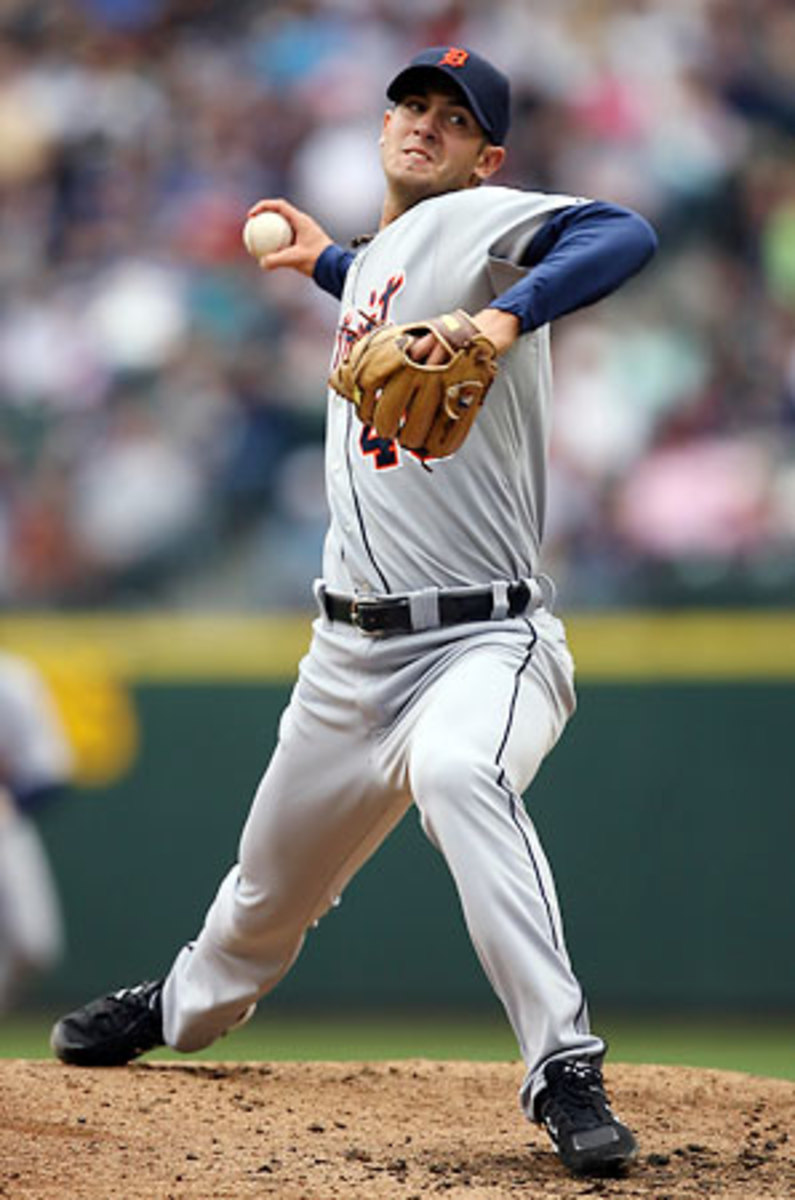
Twenty-year-old phenom Porcello plays key role in Tigers' playoff run
DETROIT -- Rick Porcello stands 6-foot-5, has a four-seam fastball that touches 96 mph and a sinker that looks like it's falling off a cliff, but his catcher is worried about his facial hair, or lack thereof. "Look at his beard," said Tigers catcher Gerald Laird, staring at Porcello in the home clubhouse at Comerica Park after a recent start. "It's peach fuzz. It's all blotchy. He's not a man yet. He's still a kid."
Porcello is 20, one year removed from Class-A Lakeland, two years removed from Seton Hall Prep School in New Jersey. He was slated to start this season in Double-A, but Jeremy Bonderman had problems with his shoulder, Nate Robertson had problems with his elbow and Dontrelle Willis had problems with his head. Needing someone with a clean bill of health to round out their starting rotation, the Tigers turned to Porcello, despite all the risks associated with rushing young pitchers to the big leagues. He has responded by winning 13 games, more than any underage pitcher since Dwight Gooden in 1985.
Unlike David Clyde and Todd Van Poppel and Matt Anderson and so many other flame-throwing flame-outs before him, Porcello barely even needed an acclimation period. He went 5-0 with a 1.50 ERA in May, and if anything, success came too easily for him. Hitters adjusted to his sinker in June and Porcello began the rapid descent familiar to pitching phenoms. But Tigers manager Jim Leyland stepped in and broke his fall. Leyland skipped Porcello's turn in the rotation in early July, giving him 16 days off, including the All-Star break. The respite was unorthodox, but for Porcello, it was critical. Here is a pitcher who only threw 125 innings last year, was running headlong into the so-called rookie wall and was in danger of exhausting himself before the most meaningful stretch of the season.
"He's an awfully young man," Leyland said. "An arm like that, you're very conscientious to take care of it as well as you can. I won't overtax him. He'll be pitching long after I'm covered up."
Porcello hated missing the time, but now that he has inserted himself back into the American League Rookie of the Year conversation, he sees the value in it. "Skip gave me the rest before the All-Star break so I'd stay strong," Porcello said. "It worked."
Porcello had an opportunity to refresh both his arm and his approach. Early in the season, he relied heavily on his sinker and used his vaunted four-seamer mainly just to back hitters off the plate. But in the past month, he has gained confidence in the fastball. "Now he's using it to get outs," Laird said. "Righties are looking for the sinker and he's throwing them the four-seamer away."
Porcello's heat is the main reason he was among the most coveted prospects heading into the 2007 draft. The Tigers, picking 27th, believed they had no shot at him. But Porcello was represented at the time by Scott Boras, so teams feared he would be near-impossible to sign. Many players have fallen a few spots in the draft because of Boras. But Porcello plummeted all the way from the top five, where he was projected, to the bottom of the first round. "We were absolutely shocked," said Dave Dombrowski, the Tigers president and general manager. "We had no idea he'd be available."
The Tigers took Porcello and signed him to a four-year deal worth $7.3 million. It was the richest contract ever given to a high school player taken in the draft, but Porcello is a bargain compared to Bonderman, Robertson and Willis, who are under contracts paying them a total of $88 million. Big-market teams most notably demonstrate their might through free agency, but they also possess an essential advantage in the draft, where they can pay a premium for players like Porcello while small-market teams are generally more reluctant.
When Porcello arrived at spring training this year, he was already a headliner and veterans lined up to check out his bullpen sessions. "He's one of the guys I wanted to catch," Laird said. "Did I think he was ready? I don't know. But the stuff was there." Laird was more concerned about Porcello's poise, his tendency to rush pitches and compound mistakes when he found himself in jams.
If Porcello wanted to win over the clubhouse, he scored all the points he needed August 11 in Boston, when he hit Red Sox slugger Kevin Youkilis in the back one inning after the Red Sox hit Tigers slugger Miguel Cabrera in the hand. When Youkilis charged the mound, Porcello body slammed him, earning a five-game suspension and another brief rest.
The Tigers do not like to address the brawl, or the respect Porcello gained from it, but they acknowledge that he has matured in a myriad of ways this summer. "He's a different guy," Laird said. "When he gives up a couple hits, he steps off, takes a deep breath, slows down a bit."
He may need to take plenty of deep breaths a couple weeks from now. The Tigers are in first place in the American League Central by 2 1/2 games, and if they hold on, they will head into the postseason with a rotation headed by Justin Verlander, Edwin Jackson and Porcello. The kid, as his catcher calls him, better start working on a playoff beard.
RELATED CONTENT:
POSNANSKI:AL Central's brutal, but hey, there's a race!LEMIRE:How Verlander got his groove back





